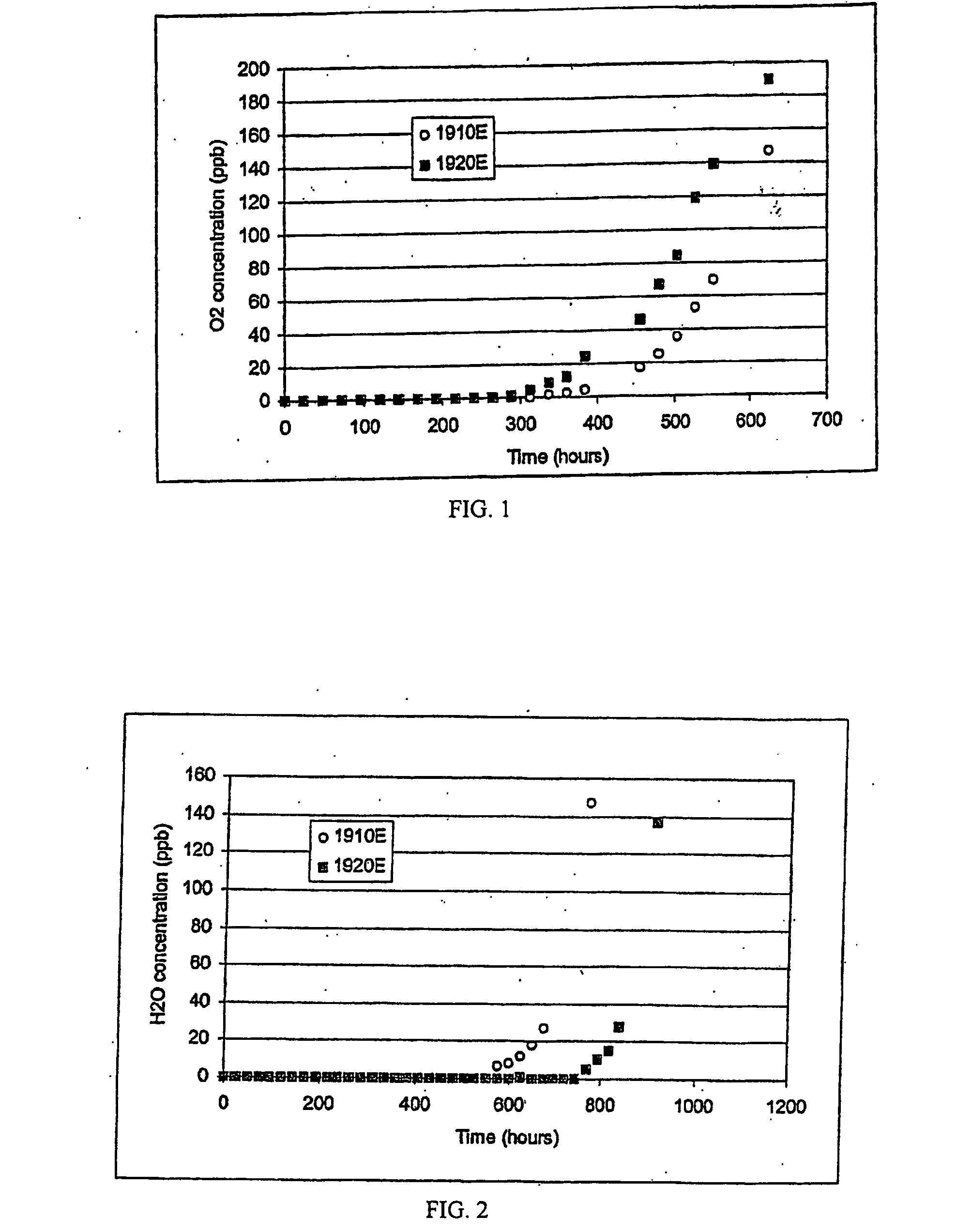Hydride gas purification for the semiconductor industry
a technology of hydrogen gas and semiconductors, applied in the direction of hydrogen sulfides, other chemical processes, separation processes, etc., can solve the problems of general stability and substantial unaffected material, and achieve the effect of increasing the capacity of contaminant removal
- Summary
- Abstract
- Description
- Claims
- Application Information
AI Technical Summary
Benefits of technology
Problems solved by technology
Method used
Image
Examples
example 1
Analysis of Lanthanide Containing Purification Substrates C and D
Purpose
[0050] The purpose of the following tests was to evaluate the performance of materials C and D by measuring their respective contaminant removal capacities for moisture, oxygen, and carbon monoxide. The compositions of the media are listed above. Carbon monoxide release at elevated temperatures was also measured for both medias. The test results for the two materials were compared.
Experimental Method
[0051] A first group of three Aeronex 70K purifier canisters were filled with C media and a second group of three 70K canisters were filled with D media. The media was activated under a 1 slm 95% Ar / 5% H2 purge at 375° C. for 40 hours.
Oxygen Capacity
[0052] One of the 70K-C media purifiers and one of the 70K-D media purifiers were tested side by side. The oxygen capacity test parameters included: a 6.5 ppm oxygen challenge, 30 psig test gas pressure, and 3 slm gas flow through each test purifier. Each purifi...
example 2
Carbon Monoxide Release From Hydride Gas Purifiers
Purpose
[0065] The purpose of the following test was to compare the performance of the current hydride gas purifier technology as taught by Alvarez U.S. Pat. No. 6,241,955, (A media) and the new hydride gas purifier material of the instant invention (E media) with respect to carbon monoxide release at room temperature and at elevated temperatures. The carbon monoxide capacity of each media was also measured.
Experimental Method
[0066] A first Aeronex 70K purifier was filled with A media and a second 70K purifier was filled with E media. The compositions of the media are shown above.
[0067] The purifiers were activated with a 1 slm 95% Ar / 5% H2 purge at 375° C. for 40 hours. The Hewlett-Packard GC equipped with a methanizer and FID was calibrated to measure ppb levels of carbon monoxide. A standard addition method using a cylinder with 351 ppm CO in nitrogen was used. Each test purifier was checked for CO release at room temperatu...
example 3
Comparison of water and oxygen removal capacity of non-lanthanide and lanthanide medias
Purpose
[0074] The purpose of the following tests was to evaluate the performance of A, B and E media by measuring their respective contaminant removal capacities for moisture and oxygen. The E media is a lanthanide based media. The C media is a manganese oxide based media. The A media is the manganese iron material currently used for hydride gas purification. Compositions of all the media are given above.
Experimental Method
[0075] Pairs of Aeronex 70K canisters were filled with each of the A, B or E media, six canisters total. The filled canisters were activated under 1 slm 95% Ar / 5% H2 purge at 375° C. for 40 hours.
Oxygen Capacity
[0076] The oxygen capacity test parameters included: a 6.5ppm oxygen challenge, 30 psig test gas pressure, and 3 slm gas flow through each test purifier. Each purifier was checked for breakthrough every weekday throughout the test. Oxygen concentration in the te...
PUM
| Property | Measurement | Unit |
|---|---|---|
| Temperature | aaaaa | aaaaa |
| Fraction | aaaaa | aaaaa |
| Fraction | aaaaa | aaaaa |
Abstract
Description
Claims
Application Information
 Login to View More
Login to View More - R&D
- Intellectual Property
- Life Sciences
- Materials
- Tech Scout
- Unparalleled Data Quality
- Higher Quality Content
- 60% Fewer Hallucinations
Browse by: Latest US Patents, China's latest patents, Technical Efficacy Thesaurus, Application Domain, Technology Topic, Popular Technical Reports.
© 2025 PatSnap. All rights reserved.Legal|Privacy policy|Modern Slavery Act Transparency Statement|Sitemap|About US| Contact US: help@patsnap.com



